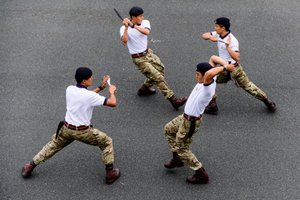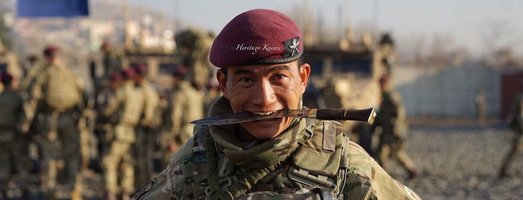In these pages is the story of how the Gorkhali Kingdom rose, expanded and developed. The Military History pages is a supplement to the collection of Arms & Armour at the National Museum of Nepal. The text itself has several limitations, it is not a complete history nor is it about the weapons, it is about the historical context in which these weapons were developed and used in, while Nepal was being created and fought for by brave men on both sides and safeguarded. The material in the collection spans from the mid 16th to early 20th century.
We will here make a journey to a time when “Nepal” as a country didn’t exist as it was only created into a nation-state in the late 1760´s. Prior to national unification the land we call Nepal consisted of many smaller kingdoms, principalities and areas, I will refer to them as principalities and at times as kingdoms. The text is written for the reader who is curious to understand the historical context to better be able to form an opinion and appreciate the collection for what it is. The focus here is Nepals and the GORKHALI military history and in that specially focus has been given on the KHUKURI / KUKRI knife which has played a central role over many centuries and the very reason for these pages. All the pages direct or indirectly relate to this legendary knife! The various pages are outlined above.
History and warfare go hand in hand, the country known as Nepal is no exception to the laws of history. Formerly Nepal was known as the Dominions of the Gorkha King, The Gorkha Kingdom (Gorkha Rajye) and is known for its fine soldiers called Gorkhali/Gurkhas/Gorkhas and its amazing nature and famous mountains which European royalty came to visit.
We start in Gorkha, a medium town and district in central Nepal, between Kathmandu and Pokhara, approx. 140 km from the capital, Kathmandu, by road. Gorkha town is the district capital of the larger Gorkha district and formerly the seat of the House of Gorkha which made Nepal into a nation. It has for the past centuries been famous for its hilltop castle, Gorkha Durbar, the home of the Shah dynasty and from where the words “Gurkha” and “Gorkha” come from. Gorkhali, Gorkhas and Gurkhas, terms which are often used freely but upon a closer look have a different meaning is briefly examined below, in the next section where I have made an attempt to define the Gorkhali/Gurkha/Gorkha better.


In common these words referes to the soldier and people who has a origin in Nepal. The Gurkhas/Gorkhas grew out of the Gorkhali Army and were recruited into the British East India Company´s military in April 1815, from which the words “Gurkha” / “Gorkha” are applied. The words come from the earlier “Gorkhali” military (later becoming the Nepalese Army), which hail from the dominions of the King of Gorkha (a town in central Nepal). I further elaborate on the issue in the page History & Education which gives some insights into the past, its politics and issues in an attempt to try to understand the lack of a proper history.
Further down we continue to explore the battles which lead to the Kingdom of Gorkha to become the Kingdom of Nepal, now a republic in transition. Democracy or Democrazy we as a nation is still figuring out but follow in many ways the known and unknown ways of the past, history afterall is a way to find the red thread that connects it all and make sense of where we are today and our past.
Nepal as a nation has its roots in the mid 18th century, the area ruled by the Shah kings of Gorkha expanded in all four directions to become the country of Nepal, conquering the Kathmandu Valley in 1768-69 by the Gorkhali (early Nepalese) military. The modern borders were agreed on in the late 18th and early 19th century, the Treaty of Betrawati (1792) and Treay of Segauli (1816), following the Sino-Nepalese War & the Anglo-Gorkha War.
Nepals roots are much older and complex with the rise and fall of ancient empires, people immigrating, meditating monks and mythological creatures, a rich mix of myths and legends vs. science and reality which are at times bluered.
In the process of making (unifing Nepal) over the 18th and 19th century many battles and wars were fought in which the Gorkhali military used mainly traditional weapons to fight, such as the Khukuri/Kukri knife, Kora and Tulwar swords. Canons, rifles and muskets were also used but not in any extensive numbers and when found date to the later half of the 18th century and after. The first units being issued rifles in approx. 1762.
For various reasons over time and due to lack of documentation we have also lost a large part of our past, our heritage, though soceity remains “traditional”. Tradition as such is always evolving and changing. Similarly Kukri/Khukuri knives called traditional have adapted to the times, the nature of warfare, needs of its users and skills of its makers. Using the terms historical, traditional and much else should also therefor come with a responcibility, a good understanding of the past or the meaning of the words bear little meaning.
These pages are for those whom through time have served and fallen, known or unknown men and women of all walks of life that in one way or another contributed to where we are today as Gorkhalis, Gorkhas, Gurkhas and humanity as children of mother earth of any geographic area or country. That the memory of the past, of our heritage, may not be lost. Therefore these pages are part of a documentation of history & heritage.

Heritage Knives as a semi-custom Khukuri & Knife production company, sharing a deep interest in the history and heritage of the Kukri/Khukuri/Khukri knife, which is our life line. Your support by reading, sharing and aquiring a Blade from us helps us to keep production and research going.
In About Us we have explained more in deepth our journey becoming Kukri producers and knife makers, aiming to make the finest blades, in the foothills of the Himalayan mountains
